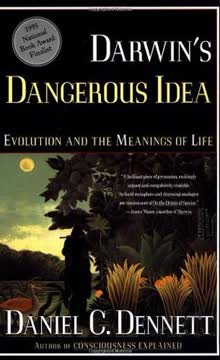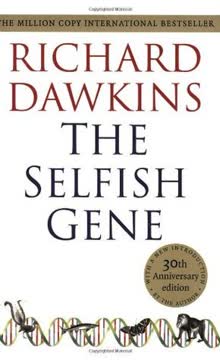Key Takeaways
1. Evolution proceeds gradually up "Mount Improbable"
To suppose that the eye, with all its inimitable contrivances for adjusting the focus to different distances, for admitting different amounts of light, and for the correction of spherical and chromatic aberration, could have been formed by natural selection, seems, I freely confess, absurd in the highest possible degree.
Climbing Mount Improbable. Darwin's seemingly improbable statement actually introduces a powerful metaphor for understanding evolution. Mount Improbable represents the apparent impossibility of complex adaptations arising by chance. However, evolution doesn't leap up sheer cliffs in a single bound. Instead, it follows gentle slopes on the mountain's far side, taking small, incremental steps over long periods of time.
Gradual improvements. Each step represents a slight improvement in fitness, which accumulates over generations. This process can transform simple light-sensitive patches into complex camera-like eyes, or basic appendages into wings capable of powered flight. The key is that each intermediate stage must be functional and beneficial in its own right.
- Examples of gradual evolution:
- Light-sensitive patch → cup-shaped depression → pinhole camera → lens-equipped eye
- Skin flaps for gliding → proto-wings → powered flight in insects, birds, and bats
- Fossil evidence often reveals these intermediate forms
- Computer simulations (like Dawkins' "biomorphs") demonstrate how small changes accumulate
2. Eyes have evolved independently at least 40 times
It has been authoritatively estimated that eyes have evolved no fewer than forty times, and probably more than sixty times, independently in various parts of the animal kingdom.
Convergent evolution. The repeated independent evolution of eyes demonstrates the power of natural selection to find similar solutions to common problems. This convergence occurs because the basic principles of optics and light detection remain constant, regardless of an organism's evolutionary history.
Diverse eye designs. While all eyes serve the function of detecting light, they've evolved in a variety of ways:
- Simple light-sensitive patches (some jellyfish)
- Pinhole eyes (Nautilus)
- Compound eyes (insects and some crustaceans)
- Camera-type eyes (vertebrates, cephalopods)
- Mirror eyes (scallops)
Each type of eye represents a different way of solving the problem of gathering visual information, suited to the specific needs and evolutionary constraints of the organism.
3. Natural selection is not random, but mutation is
Mutation may be random, but selection definitely is not.
Misunderstanding randomness. A common misconception about evolution is that it's entirely based on random chance. While mutation – the source of genetic variation – is indeed random, natural selection is a non-random process that systematically favors beneficial traits.
The power of cumulative selection. Natural selection acts as a filter, preserving and amplifying advantageous mutations while eliminating harmful ones. Over time, this process can produce highly complex and well-adapted organisms:
- Mutations provide raw material for change
- Selection preserves beneficial variations
- Accumulation of small changes leads to large-scale adaptations
- The process is directional, not purely random
Computer simulations, like Dawkins' "weasel program," demonstrate how quickly non-random selection can produce seemingly improbable results compared to pure chance.
4. Artificial selection demonstrates evolution's power
Dog generation times are a little shorter than ours but, even so, it takes more than a human lifetime to propel dog evolution to any notable extent. Humans have bred chihuahuas in about a ten-thousandth of the time it took nature to breed wolves from their chihuahua-sized (though not chihuahua-shaped), insectivorous ancestors who lived back when the dinosaurs died out.
Accelerated evolution. Artificial selection, the process by which humans deliberately breed plants and animals for desired traits, provides a powerful demonstration of evolution's capacity for change. This process has produced dramatic transformations in domesticated species over relatively short time scales.
Examples of artificial selection:
- Dogs: From wolves to diverse breeds like Chihuahuas and Great Danes
- Crops: Wild cabbage into broccoli, cauliflower, Brussels sprouts, etc.
- Pigeons: Darwin's own experiments showing extreme variety from a common ancestor
Artificial selection differs from natural selection in speed and direction, but it operates on the same principles of inherited variation. It shows how quickly and dramatically evolutionary processes can reshape organisms when selection pressures are strong and consistent.
5. Organisms are vehicles for gene replication
An elephant is a huge digression within a computer program written in DNA language.
The selfish gene perspective. Dawkins proposes viewing organisms not as the primary units of evolution, but as elaborate vehicles constructed by genes for their own replication. This shift in perspective helps explain many aspects of biology and behavior.
Implications of gene-centered evolution:
- Bodies are "survival machines" for genes
- Adaptations ultimately serve gene propagation, not individual or species survival
- Explains seemingly altruistic behaviors (when they benefit related genes)
- Illuminates conflicts between levels of selection (e.g., genetic, individual, group)
This view doesn't diminish the complexity or wonder of organisms, but reframes our understanding of why that complexity exists. It also helps explain phenomena like aging – bodies are disposable once they've served their purpose in gene replication.
6. Kaleidoscopic embryology enhances evolutionary potential
Kaleidoscopic embryologies have what it takes to inherit the earth.
Efficient variation. Kaleidoscopic embryology refers to developmental processes that produce symmetrical or repeated structures. This type of embryology can generate significant variation with relatively small genetic changes, increasing evolutionary potential.
Advantages of kaleidoscopic development:
- Mutations affect multiple body parts simultaneously
- Allows for rapid exploration of new body plans
- Preserves functional symmetry (e.g., left-right body symmetry)
- Examples:
- Segmentation in arthropods
- Radial symmetry in echinoderms
- Repeated structures like vertebrae or flower petals
This concept helps explain how complex body plans can evolve relatively quickly and why certain symmetrical or repetitive structures are so common in nature.
7. Symbiotic relationships evolve through mutual exploitation
It is better to think of each as using the other for its own good. It is a kind of mutual exploitation in which each benefits from the other enough to make the costs of helping it worth paying.
Coevolution, not altruism. Symbiotic relationships in nature are often portrayed as harmonious partnerships. However, Dawkins argues that they're better understood as cases of mutual exploitation where both parties benefit more than they lose.
Examples of symbiotic relationships:
- Flowers and pollinators (e.g., bees)
- Ants and acacia trees
- Gut bacteria and their animal hosts
These relationships evolve not out of altruism, but because each partner gains more than it invests. This perspective helps explain both the stability and potential conflicts within symbiotic systems. It also cautions against overly romanticized views of nature as a perfectly harmonious system.
8. The fig and fig wasp exemplify coevolution's intricacy
Almost every species of fig (and there are more than 900 of them) has its own private species of wasp which has been its lone genetic companion through evolutionary time since the two of them split off together from their respective predecessors.
Extreme specialization. The relationship between figs and their pollinating wasps represents one of the most intricate examples of coevolution in nature. This system demonstrates how two species can become utterly dependent on each other through evolutionary time.
Key aspects of the fig-wasp relationship:
- Figs are actually inverted flower clusters, not true fruits
- Each fig species has a unique wasp pollinator
- Wasps lay eggs inside figs, while also pollinating them
- Fig provides food and shelter for wasp larvae
- Wasp life cycle is precisely timed to fig development
This relationship exemplifies how evolution can produce highly specialized adaptations and interdependencies. It also illustrates the concept of "evolutionary arms races" where two species continually adapt to each other over time.
Last updated:
FAQ
What's Climbing Mount Improbable about?
- Exploration of Evolution: Richard Dawkins explores evolutionary concepts, focusing on how complex biological structures evolve through gradual changes.
- Mount Improbable Metaphor: The metaphor illustrates that seemingly improbable evolutionary outcomes can be achieved through small, incremental steps.
- Designoid Objects: Dawkins discusses living beings that appear designed but are actually the result of natural selection, contrasting them with truly designed objects.
Why should I read Climbing Mount Improbable?
- Understanding Evolution: The book provides a clear explanation of evolutionary biology, making complex concepts accessible to a general audience.
- Challenging Misconceptions: Dawkins addresses misconceptions about evolution, emphasizing the role of natural selection over chance.
- Rich Examples: Filled with vivid examples and illustrations, the book helps readers visualize and understand evolutionary processes.
What are the key takeaways of Climbing Mount Improbable?
- Natural Selection vs. Chance: Evolution is driven by natural selection acting on random mutations, not by chance alone.
- Gradualism in Evolution: Complex structures evolve through gradual changes, not sudden leaps, as illustrated by the evolution of the eye.
- Multiple Evolutionary Paths: There are diverse evolutionary paths, represented by different peaks on Mount Improbable, highlighting adaptation diversity.
What are the best quotes from Climbing Mount Improbable and what do they mean?
- “The sheer height of the peak doesn’t matter...”: This quote emphasizes that evolution is a gradual process achieved through small steps.
- “Designoid objects are not accidental.”: It highlights that living organisms' complexity arises from evolutionary processes, not intentional design.
- “Natural selection is a non-random force...”: This underscores the role of natural selection in shaping species evolution, countering the misconception of randomness.
How does Richard Dawkins explain the evolution of the eye in Climbing Mount Improbable?
- Multiple Evolutions: Eyes have evolved independently at least forty times, showcasing evolutionary versatility.
- Gradual Development: The eye evolved through small, beneficial changes, allowing for functional intermediate forms.
- Computer Simulation: Dawkins references a simulation showing that complex eyes could evolve from simple beginnings in 364,000 generations.
What is the metaphor of Mount Improbable in Climbing Mount Improbable?
- Symbol of Evolution: Mount Improbable represents the gradual journey of evolution, where organisms adapt over time.
- Cliffs and Slopes: Steep cliffs symbolize impossible leaps, while gentle slopes represent gradual evolutionary steps.
- Encouragement for Understanding: The metaphor encourages appreciation of evolution's complexity and diverse adaptation paths.
What are designoid objects according to Climbing Mount Improbable?
- Definition: Designoid objects are organisms that appear designed due to complexity but result from evolutionary processes.
- Contrast with Designed Objects: Unlike intentionally designed objects, designoid objects arise from natural selection acting on mutations.
- Examples in Nature: Dawkins provides examples like the eye to illustrate complexity arising without a designer.
How does Climbing Mount Improbable challenge creationist views?
- Countering Misconceptions: Dawkins explains evolution mechanisms and evidence, emphasizing it is not a theory of chance.
- Emphasis on Evidence: The book presents evidence from genetics and paleontology supporting evolution.
- Understanding Natural Selection: By clarifying natural selection's role, Dawkins challenges the notion of a designer for complex life forms.
How does Richard Dawkins address the argument of "irreducible complexity" in Climbing Mount Improbable?
- Critique of Irreducible Complexity: Dawkins argues it misunderstands evolution's gradual nature, where complex systems evolve from simpler forms.
- Intermediate Forms: He provides examples of functional intermediate forms, countering the idea of non-gradual evolution.
- Natural Selection's Role: The book emphasizes natural selection favoring beneficial intermediate forms, allowing complex system development.
What role do mutations play in evolution as described in Climbing Mount Improbable?
- Source of Variation: Mutations provide genetic variation for natural selection to act upon.
- Randomness and Selection: While mutations are random, natural selection is non-random, selecting beneficial traits.
- Cumulative Effect: Beneficial mutations accumulate over generations, leading to significant evolutionary changes.
What is the significance of the title Climbing Mount Improbable?
- Metaphor for Evolution: The title represents the gradual and challenging process of evolution, with each step as a small adaptation.
- Overcoming Improbability: It suggests that improbable outcomes can be achieved through incremental changes over time.
- Journey of Discovery: The title reflects the scientific journey of understanding evolutionary biology's intricacies.
How does Richard Dawkins use computer models in Climbing Mount Improbable?
- Simulating Evolution: Dawkins uses computer models to simulate evolutionary processes, particularly eye evolution.
- Visualizing Concepts: Simulations help visualize abstract evolutionary concepts, making them accessible to readers.
- Testing Hypotheses: Models test evolutionary hypotheses, providing a framework for understanding natural selection dynamics.
Review Summary
Climbing Mount Improbable receives mostly positive reviews for its clear explanations of evolution and natural selection. Readers appreciate Dawkins' engaging writing style and use of examples to illustrate complex concepts. Many find the book fascinating and enlightening, particularly the chapters on eyes, wings, and fig wasps. Some criticize Dawkins' arrogance and repetitiveness. Overall, reviewers recommend it as an accessible introduction to evolutionary biology, though a few find certain sections challenging or outdated.
Similar Books









Download PDF
Download EPUB
.epub digital book format is ideal for reading ebooks on phones, tablets, and e-readers.













